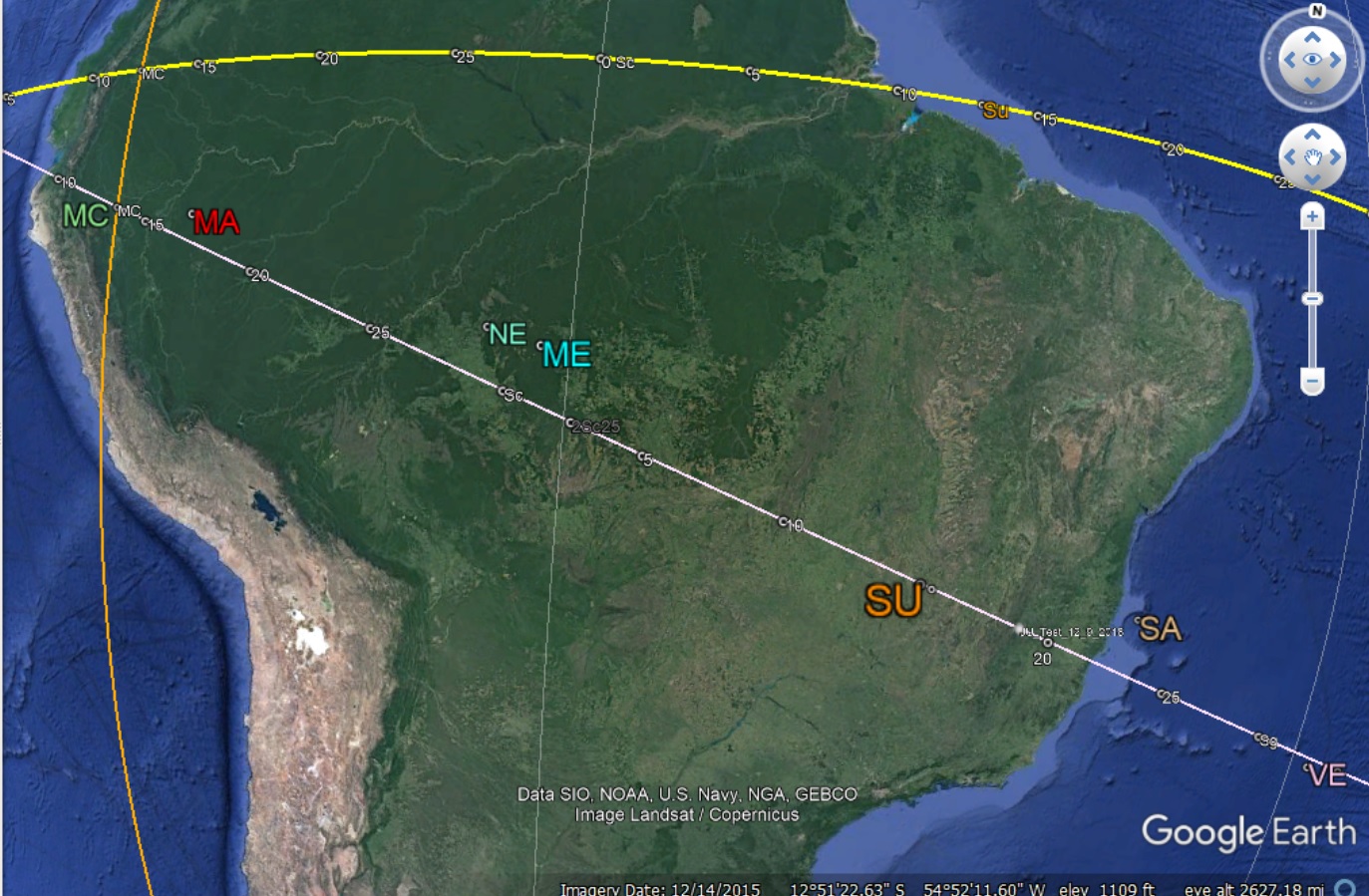
(click covers for more information) |
Google Earth is an amazing program - and it is free! That's why we have created a module in Omnicycles that converts the information of any Natal Chart into a file format that can then be opened on Google Earth, allowing you to view that chart's positions projected onto the globe: you will see your chart "for real": |

The above is the "Google Earth" representation of part of my own chart: namely, the fourth quadrant (Houses 10 to 12), where I have Mars, Neptune, Mercury, Sun, Saturn and Venus. In "normal" natal chart format, that quadrant looks like this:
|

Why is it important to understand the astronomy of a chart? So that you will be able to deepen your interpretative skills. For you see, by comprehending factors such as the Midheaven, the Ascendant, the Zenith, and what I call the "Ecliptic Zenith" point (that point on the Ecliptic that is closest to your place of birth - and no, that is almost never the Midheaven!), you will find that your intuitions about the meanings of the planets near those points will be significantly increased. You will also learn to truly understand the different coordinate systems: Ecliptic; Right Ascension; Prime Vertical; Horizon; Declination; Latitude. You will see why using Ecliptic positions alone (the habit of most astrologers) gives only a partial picture of the chart. For instance: how many astrologers regularly use parallels of declination in their interpretations? When you view a chart on Google Earth, you will see exactly what a parallel is, and it will become clear that this is an extremely important dimension of chart interpretation. And not only that: viewing a chart on Google Earth is a lot of fun, too! In astrology, we deal with what one might call "Planetary Zeniths", that is, points on the Earth that are directly below each planet at a specific moment. I'm sure you've heard, for instance, that the left side of the chart represents the part of the globe that is to the east of your birth place. Assuming that you have the Sun (for example) at the beginning of your eleventh house: just how far east is your Sun? And over what place on the globe was it exactly when you were born? You will be able to see all this in great detail: cast your chart on Google Earth, view your planetary positions, and then use the zoom feature of Google Earth to see precisely where your Sun is. But the fun and learning doesn't stop there. Using the "draw" features of Google Earth, you might wish to experiment. For example: In the folloiwng picture, you can see how I have used Google Earth's "draw circle" feature to create declination lines for my planets. Such lines show the daily paths of the planets around the Earth as they move from east (to the right of the map) to the west (left side). Do you see how the declination lines for Mercury and Neptune, and for the Sun and Saturn, are right next to each other? That means that those planets are in "parallel of declination" with each other (Mercury parallel Neptune, and Sun parallel Saturn). |

Parallels are very strong factors in a chart. If two planets are already in conjunction, a parallel makes that conjunction even stronger. In my case, I have an ecliptic aspect of Sun conjunction Saturn, though the orb is over 7 degrees. However, I have a close parallel of declination (only 8 minutes of orb), so my Sun-Saturn conjuntion is considerably stronger than it would be if those two declination lines weren't so close together. Of course, Omnicycles has lists of planetary positions that will show you aspects such as parallels much quicker. Nonetheless, viewing such things on the Earth will no doubt help you to recognize the importance of such aspects. Remember that old Charlie Chaplin film, "The Great Dictator", and the scene where he is playing with a huge balloon that resembles a globe? Well, I confess that this is the way I have often felt when viewing a chart using Omnicycles' "Google Earth" feature... |
Give it a try, and you'll see what I mean! I believe that Omnicycles' "Google Earth" module is the very best tool available anywhere today to help the astrologer learn about just what a natal chart is. In addition, I can say that using this tool over many months has not only given me excellent insights into the chart itself, but has often served as an aid to understanding certain techniques, and even to develop new techniques, based on the astronomy of the chart. I can honestly say that this feature alone is easily worth paying for. But this is your lucky day, for the fantastic "Omnicycles/Google Earth" module is simply one more feature of the complete free Omnicycles software! Once you start using this feature, you will gain a true understanding of just what a chart is. And don't be surprised if this knowledge inspires you to come up with your own interpretative techniques! So what are you waiting for? Click the button below to get it right now... |


